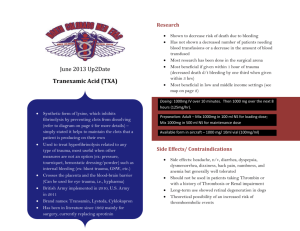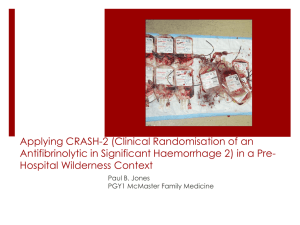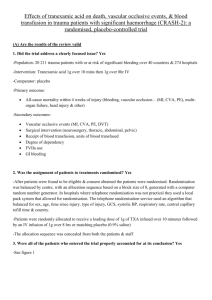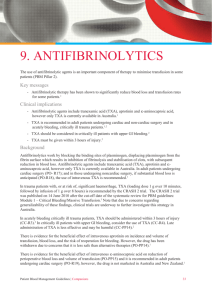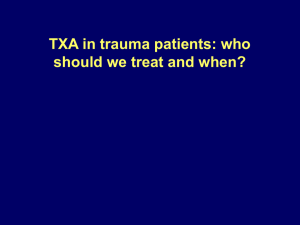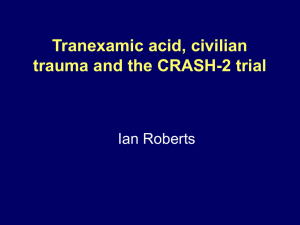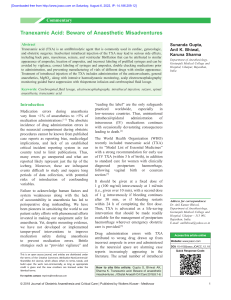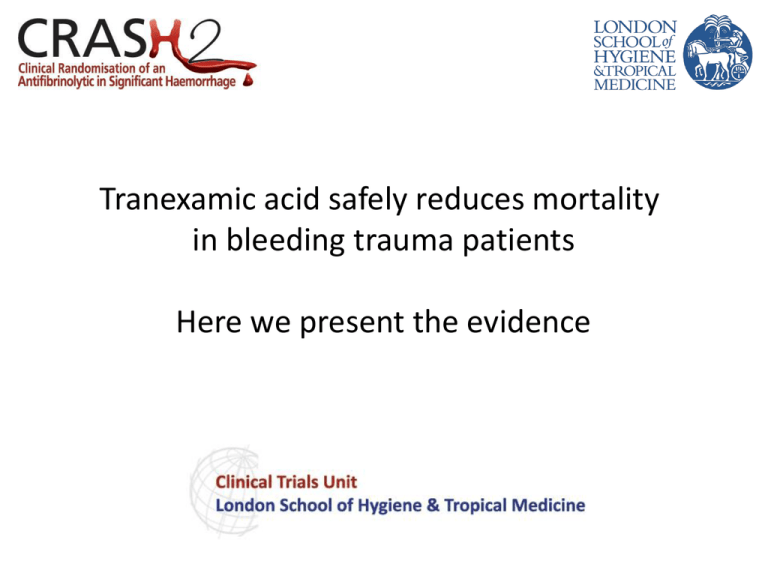
Tranexamic acid safely reduces mortality
in bleeding trauma patients
Here we present the evidence
Millions bleed to death after trauma each year
There are millions of trauma deaths each year. Many
patients survive to reach hospital. This slide shows the
causes of in-hospital trauma deaths
Bleeding
45%
CNS injury
41%
Other
4%
Organ failure
10%
Coagulation and Fibrinolysis
In bleeding trauma patients:
Coagulation occurs rapidly at the site of
damaged blood vessels.
Fibrinolysis breaks down blood clots.
In patients with serious bleeding fibrinolysis
can make bleeding worse.
Fibrinolysis
Plasminogen activators from injured blood
vessel convert plasminogen to plasmin.
Plasmin binds to the fibrin blood clot and
breaks it down. This is fibrinolysis.
Tranexamic acid reduces fibrinolysis
Tranexamic acid inhibits plasmin and
reduces clot breakdown.
Tranexamic acid reduces surgical bleeding
In surgical patients tranexamic acid (TXA) reduces the
need for blood transfusion by about one third.
Need for transfusion
RR (95% CI)
TXA
0.4
0.8
TXA better
0.61 (0.54–0 .69)
1.2
1.6
TXA worse
The CRASH-2 Trial
Tranexamic acid reduces clot breakdown
Tranexamic acid reduces bleeding in surgery
Many trauma patients die from bleeding
To see if tranexamic acid saves lives in bleeding
trauma patients we conducted a very large
Randomised Controlled Trial called CRASH-2
Methods
Over 20,000 bleeding trauma patients were randomly
allocated to get tranexamic acid or matching placebo
We included all adult trauma patients who were
within 8 hours of their injury, if their doctor thought
that they had or could have significant haemorrhage
We then collected data on death in hospital within
4 weeks of injury and all important side effects
We used this dose of tranexamic acid
Treatment
Tranexamic acid dose
Loading
1 gram over 10 minutes
(by slow intravenous injection or an
isotonic intravenous infusion)
Maintenance
1 gram over 8 hours
(in an isotonic intravenous infusion)
We randomised many trauma patients
Patient enrolment
20,211 patients
from 274 hospitals
in 40 countries
We had excellent follow up
20,211 randomised
10,096 allocated TXA
3 consent
withdrawn
10,093 baseline data
33 lost
to follow-up
Followed up = 10,060
(99.7%)
10,115 allocated placebo
1 consent
withdrawn
10,114 baseline data
47 lost
to follow-up
Followed up = 10,067
(99.5%)
Baseline factors were well balanced
TXA n (%)
Placebo n (%)
Gender
Male
8,439 (83.6)
8,496 (84.0)
Female
1,654 (16.4)
1,617 (16.0)
0
1
<25
2,783 (27.6)
2,855 (28.2)
25–34
3,012 (29.8)
3,081 (30.5)
35–44
1,975 (19.6)
1,841 (18.2)
>44
2,321 (23.0)
2,335 (23.1)
2
2
[not known]
Age (years)
[not known]
Baseline factors were well balanced
TXA n (%)
Placebo n (%)
Time since injury (hours)
≤1 hour
3,756 (37.2)
3,722 (36.8)
>1 to ≤3 hours
3,045 (30.2)
3,006 (29.7)
>3 hours
3,006 (29.7)
3,380 (33.4)
5
6
Blunt
6,812 (67.5)
6,843 (67.7)
Penetrating
3,281 (32.5)
3,271 (32.3)
[not known]
Type of injury
Baseline factors were well balanced
TXA n (%)
Placebo n (%)
Systolic Blood Pressure (mmHg)
>89
6,901 (68.4)
6,791 (67.1)
76–89
1,615 (16.0)
1,697 (16.8)
≤75
1,566 (15.5)
1,608 (15.9)
11
18
Severe (3–8)
1,799 (17.8)
1,839 (18.2)
Moderate (9–12)
1,353 (13.4)
1,351 (13.4)
Mild (13–15)
6,934 (68.7)
6,908 (68.3)
[not known]
7
16
[not known]
Glasgow Coma Score
This is what we found
Cause of death
TXA
Placebo
10,060 10,067
Risk of death
P value
Bleeding
489
574
0.85 (0.76–0.96)
0.0077
Thrombosis
33
48
0.69 (0.44–1.07)
0.096
Organ failure
209
233
0.90 (0.75–1.08)
0.25
Head injury
603
621
0.97 (0.87–1.08)
0.60
Other
129
137
0.94 (0.74–1.20)
0.63
Any death
1463
1613
0.91 (0.85–0·97)
0·0035
Most of the benefit is for bleeding deaths
TXA (n= 10,060)
Placebo (n= 10,067)
489 (4.9%)
574 (5.7%)
RR (95% CI)
0.85 (0.76–0.96) 2P=0.0077
0.8
0.9
TXA better
1.0
1.1
TXA worse
For bleeding deaths – early treatment is better
RR (99% CI)
p=0.000008
≤1 hour
0.68 (0.54–0.86)
>1 to ≤ 3 hours
0.79 (0.60–1.04)
>3 hours
1.44 (1.04–1.99)
0.85 (0.76–0.96)
.7
.8
.9
1
1.1
1.2
1.3
1.4 1.5
Treatment must be given early because
bleeding deaths happen soon after injury
1200
1000
Number of deaths
Deaths due to all other causes
800
Deaths due to bleeding
600
400
200
0
0 1 2 3 4 5 6 7 8 9 10 11 12 13 14 15 16 17 18 19 20 21 22 23 24 25 26 27 28
Days
There was no increase in thrombosis
TXA
allocated
(10,060)
Placebo
allocated
(10,067)
DVT
40 (0.40%) 41 (0.41%)
PE
72 (0.69%) 71 (0.70%)
MI
35 (0.35%) 55 (0.52%)
Stroke
57 (0.56%) 66 (0.65%)
Any
168 (1.63%) 201 (1.95%)
Risk ratio (95% CI)
.6
.7
.8
.9
TXA better
1
1.1
1.2
TXA worse
Tranexamic acid reduces symptoms
TXA
[n=10060]
Placebo
[n=10067]
No symptoms
1,483 (17.3%)
1,334 (15.8%)
1.11 (1.04 – 1.19) 0.0023
Minor symptoms
3,054 (30.4%)
3,061 (30.4%)
1.00 (0.96 – 1.04)
0.94
Some restriction
2,016 (20.0%)
2,069 (20.6%)
0.97 (0.92 – 1.03)
0.36
Dependent
1,294 (12.9%)
1,273 (12.6%)
1.02 (0.95 – 1.09)
0.63
696 (6.9%)
676 (6.7%)
1.03 (0.93 – 1.14)
0.57
1,463 (14.5%)
1,613 (16.0%)
Fully dependent
Dead
RR (95% CI)
p-value
0.91 (0.85 – 0.97) 0.0035
CRASH-2 was conducted on 4 continents and...
was shown to reduce mortality on each!
Tranexamic acid is highly cost effective
What we concluded
Tranexamic acid reduces mortality in bleeding trauma patients
Tranexamic acid does not seem to increase unwanted clotting
Tranexamic acid needs to be given early – within 3 hours of
injury
Tranexamic acid is not expensive and could save hundreds of
thousands of lives each year around the world
Tranexamic acid is now being used
After the CRASH-2 trial, tranexamic acid was added to the
WHO List of Essential Medicines (March 2011)
The military are using tranexamic acid to treat combat
casualties
Tranexamic acid is being used in hospitals around the world
Tranexamic acid could be given in ambulances

